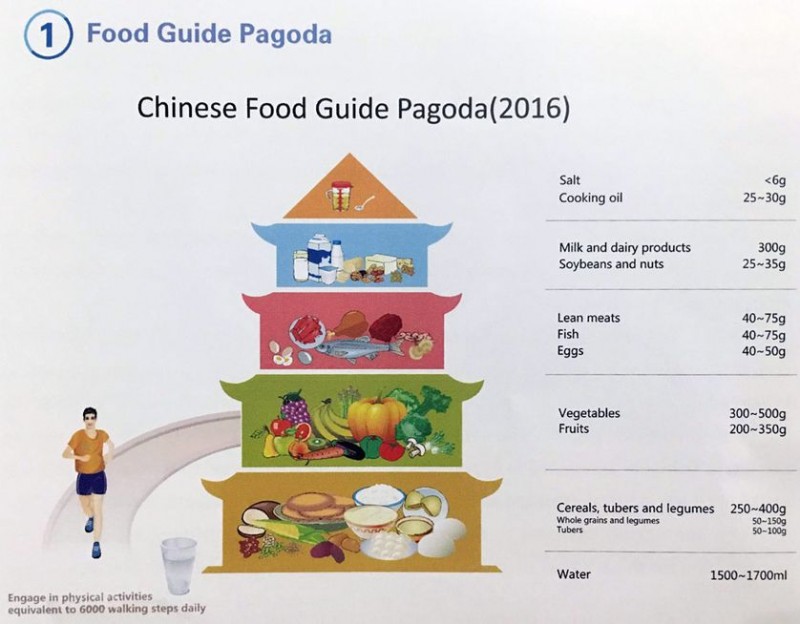Take a look at the food pyramids — even if they aren't in pyramid form — from countries around the world.
United States
In 2011, the USDA threw out the pyramid and adopted MyPlate, a simple graphic of a dinner plate divided into four rough quadrants, plus a cup to represent dairy. When put into practice the guidelines from MyPlate have eaters filling half their plate with vegetables and fruit — with a little more vegetables than fruit. The other half should be grains and protein — with more grains than protein.
The plate does not give specifics about what kinds of foods are best. It doesn't suggest to eat whole grains instead of grains made from white flour or to eat lean chicken instead of bacon. There are many supplemental materials available from the USDA for information like that.
The dairy portion of the graphic makes it seem as if every meal should be accompanied by a glass of milk, and it's no surprise that the dairy industry lobbied to have dairy included even though dairy is not necessary for a well-balanced diet. The nutrients in dairy certainly can be found in other foods.
Shortly after the MyPlate graphic was introduced, Harvard created the Healthy Eating Plate, keeping the four quadrants and adding some information about healthier choices in each quadrant and adding advice like "potatoes and French fries don't count" for the vegetables. Harvard's plate also replaces dairy with water. These small changes make a big nutritional difference in the two graphics.
Belgium
Belgium's inverted food pyramid graphically shows specific foods to eat more of and specific foods to eat in small quantities. At the very top of the pyramid is water followed by all plant-based foods. Leaner animal proteins come next. At the bottom are red meat and butter. The "as little as possible" foods might make you want to cry, though — pizza, wine, chocolate and bacon are considered among the foods to be infrequently indulged upon.The plate does not give specifics about what kinds of foods are best. It doesn't suggest to eat whole grains instead of grains made from white flour or to eat lean chicken instead of bacon. There are many supplemental materials available from the USDA for information like that.
The dairy portion of the graphic makes it seem as if every meal should be accompanied by a glass of milk, and it's no surprise that the dairy industry lobbied to have dairy included even though dairy is not necessary for a well-balanced diet. The nutrients in dairy certainly can be found in other foods.
Shortly after the MyPlate graphic was introduced, Harvard created the Healthy Eating Plate, keeping the four quadrants and adding some information about healthier choices in each quadrant and adding advice like "potatoes and French fries don't count" for the vegetables. Harvard's plate also replaces dairy with water. These small changes make a big nutritional difference in the two graphics.
Belgium
It's sound nutritional advice. As Marion Nestle said on her Food Politics blog about Belgium's pyramid, "USDA: take note."
Canada
Canada doesn't try to make it simple with one easy graphic. The country has an information-packed booklet that's over a decade old. The booklet contains serving sizes, the recommended servings per age, information about being active and more. It's a bit confusing, and the Canadian government is in the process of changing the guidelines. The new guidelines will dump the dairy and emphasize plant-based foods as a preferred source of protein, as well as recommend unsaturated fat over saturated fat, according to Huffington Post.
The new guidelines also will do something that the United States guidelines have failed to do: educate on how our food choices affect the environment and encourage people to make food choices that are more sustainable.
China

The base of the Chinese Food Guide Pagoda places whole grains, tubers and legumes in a larger portion of the pagoda than it does fruits and vegetables. If you look at the recommended amounts, though, fruits and vegetables are to be about half the day's intake. It's a little confusing if you just look at the picture. A nice addition is the physical activities recommendation — the equivalent of 6,000 walking steps a day. That recommendation is pretty clear.
Finland
Plant-based foods populate the the bottom half of the food pyramid from Finland. The design emphasizes a variety of colorful fruits and vegetables and the grains are all of the whole variety. Fish is emphasized before any meats, and like the soon-to-be Canadian guidelines, more sustainable foods are recommended. In fact, the Finnish Food Safety Authority dedicates a page of its website to explaining sustainable food choices and notes that they are often healthier choices as well.
Australia
Australia's foundation layers contain all plant-based foods: fruits, vegetables, legumes and grains. It also does something very interesting: It places lentils and beans on the pyramid twice, recognizing that they can be a suitable substitute for animal proteins.
One thing is clear from looking at these food guidelines from around the world — fruits, vegetables and other plant-based foods are being recognized as the most important part of a nutritious diet. Another thing is clear — the USDA could definitely do a better job at creating a visual eating guide for Americans.







